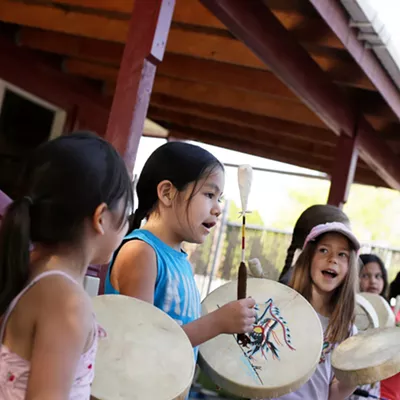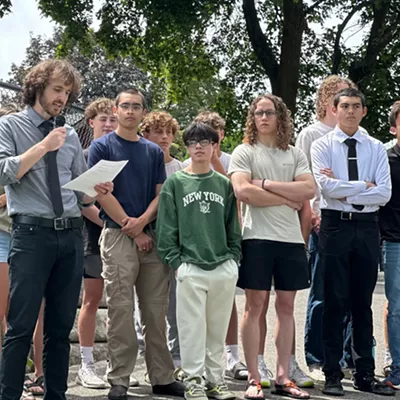That romantic worldview hasn't fully come true yet, but more farmers and consumers are thinking local. The number of farmers markets in the region has grown. Restaurants boast about cooking with and serving local ingredients. "Organic" and "locally-grown" fruits and vegetables have become more popular, despite their sometimes higher price tags.
This summer some Sandpoint community members have committed to the North Idaho Local Food Challenge, which is "focused on encouraging individuals, food establishments, and other institutions to become aware of where their food is coming from and try to increase their consumption of locally produced foods," according to coordinator Emily LeVine. The project includes a restaurant challenge "where every week this summer a different dining establishment in the Sandpoint area will highlight as many local ingredients as they can in their menu," she writes. "Also, there is a group forming to commit to eating an all-local diet (within 250 miles of their homes) for one full year."
Eating local means having to give up things like bananas and oranges. But it might also mean buying supermarket produce that can be allowed to ripen in the fields or on the trees and actually taste like they're supposed to. Beyond that, the speakers at the oil conference argued that a local food supply is likely to be more safe and less prone to supply disruptions.
This week, our cover story celebrates people who have adopted the "local" food mantra.
-- DOUG NADVORNICK
Communal Veggies
PAUL K. HAEDER
& lt;span class= "dropcap " & T & lt;/span & he residents of Tolstoy Farm, near Davenport, Wash., have heard the epithets -- hippie, commie, pinko, dropout, subsistence peasant, anarchist, alternative, anti-establishment, radical. In the right context and during the right time period, these practitioners of organic agriculture might have fit all of these labels. But Tim Pellow, Diane Reuter, Chrys Ostrander and their neighbors are reaping the benefits of the counterculture experiment of "intentional community living" first staked out with a few yurts and tents more than 43 years ago.
Tolstoy Farms, home to 40 people, is the anchor produce vendor at the Spokane Farmers Market every Wednesday and Saturday. In addition, each week during the growing season, the Mill Canyon community nestled in a verdant but rough-edged coulee provides fresh produce boxes to more than 90 customers. Those customers are investing in the future of sustainable farming, according to Pellow and Ostrander; their "Community Supported Agriculture" model is now practiced by more than 1,200 farms in Canada and the United States.
"The 280 acres we have have been taken out of the speculative real estate market in perpetuity," Ostrander says while weighing out carrots for a woman with a large cockatoo on her shoulder at the Spokane Farmers Market. "Land should not be sold as a commodity, not like whole cloth."
The average person who buys Tolstoy Farms' hearty beets, potatoes and any number of other mouth-watering vegetables probably has no sense of how the land collective first germinated, and how strongly the participants' faith in an alternative living paradigm -- non-mainstream, anti-consumerism -- guides how they plant and build relationships as marketers.
Huw "Piper" Williams, Tolstoy's founder, took part in peace marches back east during the Vietnam War and lived on a rural communal farm in Connecticut. Williams came home to Washington, getting land from his mother and grandparents. Friends from the peace movement joined him. As Ostrander points out, the early commune pilgrims attempted to live in a way that would not require violent acts, being in the military, courts, jail or police. There were no rules that regulated sexual activities or drug use. The Tolstoy Farms of the 1960s were collectively one of the more radical places in the country at the time. The commune struggled and almost fell apart several times.
Today, the co-op has matured; it's no longer home to people with nomadic spirits. Its members include massage therapists and a professor at EWU. Ostrander's early roots were cultivated in New York. He traveled from Santa Cruz, Calif., to seven "intentional communities" before finding Tolstoy in 1990. "I wanted to put down roots. In our society today, we don't create community. We leave our troubles behind instead of dealing with them."
Now Tolstoy's residents all adopt that same counterculture approach to living and viewing the world. Ostrander points out that they have no problem believing, as Gandhi did, that real estate buying and selling -- land speculation -- is a pack of lies.
"We don't presume to own the land," he says. "We steward it."
& lt;span class= "dropcap " & T & lt;/span & he Tolstoy name comes from Leo Tolstoy, the Russian count and writer of such books as War and Peace and Anna Karenina. In Anna Karenina, Tolstoy expressed his beliefs and actions through his character Levin, the landowning aristocrat who searches for a higher meaning in life. Tolstoy pursued a deeper meaning in his later years, turning away from luxury, property and pleasures for, in his mind, a more holy and just existence. He respected the land, farms and the serfs who worked the soil.
"Tolstoy Farms started with a group of people who wanted to get away from established culture," says Diane Reuter while selling creamy white and green eggplants to customers at the market. Reuter is Tim Pellow's significant other. "The pluses are that we grow our own vegetables, we're not hooked up to public utilities, and we're a community based on consensus decision making."
The Tolstoy residents have decided that people want organic vegetables. Pellow is highly aware of the draw of the organic label placed on the farm's produce. He's dismayed that huge corporations have gained a greater share of the organic market. "There's a difference between following the letter of the law and following the spiritual basis of organic farming," he says.
At Tolstoy Farms, they value the idea that farmers have to make a living at their profession, and that the customer can make that relationship with the farmer, the food and the land everlasting, sustainable and worthy of community health.
CHICKEN AND THE EGG
PAUL K. HAEDER
& lt;span class= "dropcap " & T & lt;/span & he man who runs the only certified organic farm in southeastern Washington's Garfield County had a long career farming the way most of his peers do. Now the 62-year-old operator of the 850-acre Rickman Gulch Farm near Pomeroy does it his way.
Ben Roberts grows organic wheat to feed to his chickens (both fryers and egg layers), turkeys and beef cows. He takes the process of sustainability right down the line -- up to a few years ago, he was using a team of Belgian draft horses to get the work done. His wheat isn't sprayed with pesticides, herbicides or chemical fertilizers. He takes the red wheat berries and mills them himself. "Being organic makes me more efficient, more sustainable," Roberts says while finishing off the last of 50 fryers he has been working on since 4 am.
Rickman Gulch went organic six years ago. Roberts says it took three years to get through the certification process -- which Roberts has problems with on many levels, including the high fees and regulations that he considers labyrinthine and contradictory.
He raises 3,000 birds a year, from chicks to 5-month-old plump birds, which he processes in his certified butchering shed. His birds are never frozen, always fresh, and he has customers all over the state. He hawks his organic products at the Spokane Farmers Market. He also raises 100 turkeys for Thanksgiving.
Roberts' organic eggs come from 2,000 hens; they lay for 18 months before he ships them to Seattle, usually 300 or 400 at a time.
& lt;span class= "dropcap " & R & lt;/span & oberts was once part owner of a Sedalia, Mo., meat packing business, and his stories are gruesome and hard-edged. In 1967, he realized that he had to get out of that business. It was DES (diethylstilbestrol) that convinced him to shift away from the commodity chemical-infused ag paradigm. The hormone kept the heifers from going into heat, but the USDA required it be withheld 72 hours before slaughtering.
"The heifers were raving maniacs in the feedlots when the DES was withheld, with hormones rushing through them, and they were thrashing around," says Roberts. "Their bruised bodies diminished the value of their carcasses. They were just crazy as they all were going into heat at the same time without the hormone suppressing the heat cycle."
DES was also linked to human birth defects and eventually banned in cattle. "Whenever I saw some child with a missing limb, I felt it was my fault," he says.
"Some of these cattleman say the U.S. has the best beef in the world," Roberts continues with a sardonic grin. "They're wrong, and I tell them that. You can't buy beef livers that are from U.S. cows, can you?"
Why? He says livers in commodity cows are full of tumors and lesions, a sign of poor overall health. "Customers trust farmers, not multinationalism," he says.
Roberts does without the chemicals and rues the future of the mainstream agriculture industry that relies on them. He says farmers and ranchers have allowed transnational groups like Monsanto and Archer Daniels Midland to determine their fate. The companies, he believes, are leading his colleagues on the farm down the wrong path. Roberts shakes his head when he talks about guys in Nebraska plowing out winter wheat for ethanol-bound corn, made and marketed by the multinationals. He predicts, eventually, OPEC and the oil companies will kill the ethanol industry with a few strokes on a computer keyboard -- lowering the cost of a barrel of oil by $25.
& lt;span class= "dropcap " & R & lt;/span & ickman Gulch Farm is Roberts' lifeblood and vision, although the spread came about through marriage. Nikki Rickman, his wife of 16 years, grew up on the very plot of land where their chickens are raised.
"This was the last area in the Palouse hills that got farming," Roberts says.
Rickman Gulch is a one-man operation. His bottom line is "butchered in the morning, delivered no later than the next day fresh... A person doesn't care if it's certified organic. They care about if the fryer's fresh. That I hand raised it. That I ground up the grain for feed."
Business is good. Restaurants, chefs and bakers want more of his chickens and eggs, but he can't keep up with the demand. He says it's been tough getting people to work for $11 an hour butchering cows or working as a farm hand. He says he could be doing $2 to $3 million a year in gross sales if he could get more help.
For now, Roberts keeps plugging away, knowing that one day soon he'll be out of the officially-blessed organic poultry and egg business because huge companies like Wal-Mart and grocery chains are putting pressure on Congress and Senate to water down the inherent rules governing organic.
"I'll still be doing it this way no matter what, and delivering a healthy, wholesome product," he says with a bit of sarcastic tinge. "Commodity agriculture in this country is in piss-poor shape. Organic farmers on the other hand can deal with small equipment, deal with stuff the conventional farmer just won't work with."
Tuber Tales
PAUL K. HAEDER
& lt;span class= "dropcap " & P & lt;/span & otatoes -- purple ones, orange, yellow and red, 26 varieties in all -- are the glue that keeps the Olsen family farm, 20 miles north of Colville intact. For 39-year-old Brent Olsen, his wife Angela, Brent's mother Merna, and Byran Melton, the 98-year-old grandfather on mom's side, the potato is what has galvanized their communion with sustainable farming and cattle ranching in a valley that has all the markings of a slice of nirvana -- coniferous forest with huge Engleman spruce providing shade for wildlife trails where moose, elk and deer end up rutting in the 22 acres of spuds. The tubers soak up sun while shaded creeks full of rainbow and brown trout offer dragonflies refuge.
Olsen Farms has been a staple of the Spokane Farmers Market in its various iterations for more than 12 years. The second largest farm in Stevens County counts more than 60 restaurants, stores and grocers as customers.
"I'm kind of proud of the fact that we work at this full-time," Brent Olsen says while tending to another part of his plot, where rows of eight different salad greens grow in the warm air. "Many farmers have to supplement their incomes, work off farm just to make due. We're not only working full-time, but we are providing jobs for people living here."
He's been at it for more than 12 years, having added organic-raised beef just in the past six years. Some of Olsen's local workers make the 60-mile round-trip journey from Kettle Falls to help plant, weed, harvest and pack potatoes, arugula, spinach, spicy greens, chard, lettuces and squashes. Olsen Farm's hay fields, several acres of greens and vegetables, the expanses of cattle grassland and 22 acres of potatoes are like a fountain of wholesomeness with their unsprayed, non-fumigated organic richness.
& lt;span class= "dropcap " & T & lt;/span & he Olsen farm is not a small operation -- it sends its products to both sides of the Cascades. The ghost town of Aladdin is part of their 1,200 acres; Olsen Farms encompasses 2,000 total acres with property leased for hay growing and cow grazing. It once was home to a Finnish community that supported a dance hall, post office and school. And keeping it running requires the whole family to work together.
Brent Olsen's farming roots go back to the Willamette Valley in Oregon, although he attended college in Spokane while his dad was a counselor at Gonzaga University. Brent's wife Angela also has farming in her blood. After high school, she graduated with a degree in leisure services from Central Washington University, but she's always been around orchards, and her family's Oreville Tabor Taste of Summer also includes a winery and grape growing operation. "After college, I needed to get back to the fields," she says.
Brent's mother Merna is the voice behind Olsen Farms, taking phone orders and organizing other women her age for the potato sorting, washing and packing. "Mom's a Mariners and GU fan, so she listens to games while tying all the potato bags," says Brent Olsen. Sometimes that means bagging 450,000 pounds of potatoes in one growing season.
Like most small farmers, the Olsens are realists: "It's one of the most beautiful places on earth to live, one of the hardest places on earth to work," Brent Olsen says as he shows me his high-tech potato shed and picks up rich soil while emphasizing how his life is tied to the engine of weather -- rain, frost, heat, dry soils, wind, snow pack. He knows his soils, his starch-to-sugar ratios for the tubers, and the impact global warming has on his organic farm and ranch. He's looking at the thermometer all the time, and the past two seasons he's been planting two weeks earlier than he had for years because nighttime temperatures on average are higher and spring comes on sooner.
One of Brent's aces in the hole is his sister Nora, with her Ph.D. in agronomy from the University of Idaho. He recently asked her what to do about the increasing temperatures and storage concerns for his 200 tons of spuds.
Nora's been to China, Poland, throughout the American West and most recently New Brunswick studying and talking about potatoes. Brent taps into her knowledge of this crop he sees as almost magical. "The Peruvians grew the potato in all types of soil, under all types of climatic conditions," he says. She gives him insight into humidity and temperature for storing on site. He gets the lowdown on new varieties and which diseases are running rampant. "My issue as global warming creates more and more bizarre weather up here is dealing with earlier seasons and drier growing seasons," Brent emphasizes.
The Incas grew blues, purples, pinks, yellows, reds; skinnies and fatties; some sweet and others bitter; drought resistant and water-loving kinds; smooth skinned and gnarly Russets. Altogether they had more than 3,000 varieties of cultivated and wild potatoes to work with. Agronomists have counted more than 5,000 potato varieties worldwide. Brent deals with 26 varieties to please restaurants' needs and peculiar tastes, which means he has to plant his crops based on gestation and harvest cycles. For instance, two popular potatoes, Yukon Golds and New Orleans Reds, have 120- and 70-day seed-to-harvest grow periods and both are subject to varying soil conditions and weather influences.
& lt;span class= "dropcap " & T & lt;/span & he Olsens are among the more than 300 commercial potato growers in Washington; growers here in Washington supply 20 percent of all U.S. potatoes. Brent Olsen has chosen not to use chemicals on his plants.
"What supersedes everything for me on my farm," he says, clumping up rich soil in meaty hands, "is the earth. Leaving it healthy. For wildlife." He dreams of the valley he farms as one day transformed into a vibrant area where more and more young people settle into farming not only as a way of life but a spiritual journey into the inner soul. He hopes that this area stays whole, protected from developers wanting to cut up the land into cheap lots. He sees his farm and ranch as part of a wildlife corridor. He knows a rural economy can thrive here.
"When I'm gone and dead, I'd like to believe the valley will be kept whole, intact."
Homegrown Standards
ARI LEVAUX
& lt;span class= "dropcap " & A & lt;/span & t the end of a long Friday at Clark Fork Organics farm in Missoula, co-owner Josh Slotnick placed a dinner order for his family -- onions, zucchini, carrots, basil, new garlic and French filet beans. His children jumped at the assignment. Quinn, 13, found a spading fork. Eleven-year-old Sophie grabbed a knife. And 5-year-old Natasha picked the basil, gathering only the tops. With no chemical pesticides or insecticides to wash from the crops, Natasha nibbled as she picked, and ladybugs munched on aphid larvae in the nearby apricot tree.
Yet Clark Fork Organics is not an organic farm -- not according to the U.S. Department of Agriculture. While Slotnick and his wife, Kim Murchison, haven't changed their farming practices, they also haven't paid the thousands of dollars in fees, filed the forms or shown the federally accredited inspector their compost pile.
Instead, after 14 years of farming certified organic, Clark Fork Organics has dropped the federal seal of approval and joined 11 other western Montana farms to establish the Montana Sustainable Growers Union, marketing produce under their new "Homegrown" label. The label's 10-point pledge covers everything from crop rotation to a ban on absentee ownership.
In some ways, the Homegrown members like Slotnick are no different from a spate of farmers nationwide who farm conscientiously without organic certification. Since 2002, for example, more than 400 U.S. growers have joined Certified Naturally Grown, which encourages farmers to market food locally. It requires members to adopt stricter standards than the USDA's and to inspect each other's farms to enforce compliance.
But unlike CNG, which is national in scope, Homegrown stays close to home. Its members farm within 75 miles of Missoula and pledge to sell as much as possible "locally," which in practice has meant within western Montana. They also promise to buy from locally owned stores and to cooperate with each other as "an all-around farmer-to-farmer support network," says member Luci Brieger of Victor-based Lifeline Produce.
"Homegrown is the first group in the nation to collectively drop organic certification and replace it with their own local organic guarantee," says Elizabeth Henderson of the Germany-based International Federation of Organic Agriculture Movements. "Given what happens with oil prices, wars and sabotage, sustainable food ultimately depends on local networks of people working together based on trust. It's a good idea to get used to."
According to Homegrown members, the USDA standards have not encouraged the local model. Adopted in 2002, the federal label assures consumers of certain production standards, including crops free of synthetic pesticides, and has proven popular with many farmers and organic-food advocates. But the rules also tolerate a range of large-scale food industry practices, from absentee ownership to livestock confinement, that have alienated Homegrown members.
"What we took for granted -- that organic means small and local -- is gone," says Slotnick. "The label that describes tomatoes flown 2,000 miles from a 3,000-acre monoculture worked by migrant workers who don't make a living wage -- that doesn't describe the food my family grows."
& lt;span class= "dropcap " & S & lt;/span & ince 2002, Philip Morris, Nestl & eacute;, Kellogg, Coca-Cola, Pepsi, Tyson, ConAgra, Cargill, Dole, Campbell Soup and Unilever have gained access to the $14 billion organic food market, often by purchasing smaller organic food companies. Meanwhile, Slotnick points out, the USDA standards contain no reference to living wages, family farms, rural communities, local buying or selling -- or farmer-to-farmer education.
If anything, Homegrown members say, the national organic program has hindered that education. In an effort to avoid favoritism, USDA-accredited certifiers do not answer questions about agricultural practices. Clark Fork's government-appointed inspector "couldn't tell us how other farmers handled the same problems we were having," says Slotnick. "She visited, like, a million farms that year and she couldn't tell us anything."
The founders of Homegrown wanted something smaller and friendlier. And they wanted to do it on their own. In July 2005 at the Missoula Farmers Market, Slotnick, Murchison, and the Brieger family of Lifeline Produce were bantering at their farmstands when they found highly charged common ground.
"We realized people knew we grow good food," says Slotnick. "We realized we didn't need to play the USDA game anymore. Being farmers, our knee-jerk response was, let's fix it." A core group of 15 to 20 people began to meet regularly, he says, and it was "hard to rein in the jabbering."
The group obtained a copy of the 2003 Farmer's Pledge adopted by 83 farmers of the Northeast Organic Farming Association of New York. With soil-building and growing standards equal to or stricter than the USDA's, the pledge requires commitments to practice fair labor, support the local economy and help one another become better farmers.
It became the template for Homegrown.
& lt;span class= "dropcap " & B & lt;/span & y late February 2006, the Montana farmers had drafted their pledge. In March, they registered their label with the secretary of state. The 12 members charged themselves dues based on their farming income, set up a bank account with a local nonprofit, designed a logo, and printed colorful placards and brochures. By May, the literature was on full display at farmers markets and stores.
For the most part, members simply pledged to do what they had already been practicing: build soil naturally, remain owner-operated, boost local revenue (wages have been at least eight dollars an hour), use local purveyors for tools, peat moss and fence posts alike; concentrate sales in places like Missoula and Hamilton; and share knowledge about pest control, cover crops and irrigation systems. They plan to hammer out outstanding details, including language on a living wage, over the winter.
"We're still new at this," says Luci Brieger, "still seeing where this is going. We're sharing plant starts, doing no-till research, outreach to new growers -- a welcome-wagon type thing."
Homegrown farmers take a hands-on approach to enforcing their vows: One member conducts an annual site visit to another member's farm. Known as the participatory guarantee method and practiced in 20 countries worldwide, the self-inspections "mix a checkup with education," says Slotnick. "We sit down together, go over the pledge, and compare notes about how to enhance wildlife habitat or deal with this or that disease. If my fellow member sees chemicals, she'll bust us."
This was the original model for the U.S. organic farming movement in the early 1980s, before complaints of cheating prompted calls for third-party certifiers. There's still a threat. "It's easy to cheat," says Henderson, "but it's embarrassing when you work with and sell to people you know. You want to give them your best. For national distribution, third-party certification is essential. But if you sell directly to people, a local guarantee could work." Homegrown does forbid any two farmers from inspecting each other in any given year.
So far the system has earned the confidence of consumers. As of September 2006, an informal survey of Homegrown's farmers indicated strong sales, evidently boosted by a recent widely publicized E. coli scare linked to Natural Selection, a national produce distributor.
"Demand for our spinach and salad greens has shot through the roof," says Slotnick, "and our restaurant clients are boasting about us to their customers. They know us. They trust us. This is what food security is all about."
This story originally appeared in the January/February 2007 issue of Orion magazine.














